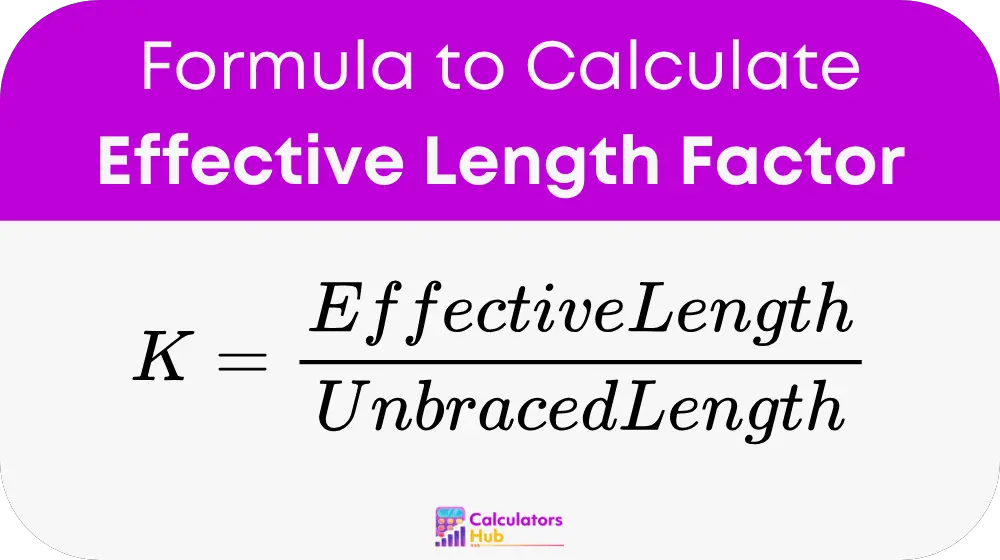La Calculadora del factor de longitud efectiva es un estructural herramienta de ingeniería que ayuda a determinar la factor de longitud efectiva (K) Para columnas. Este factor juega un papel crucial en el análisis del comportamiento de pandeo de las columnas bajo cargas axiales. Ajusta la longitud sin arriostrar de una columna en función de sus condiciones de apoyo en los extremos.
Esta calculadora se incluye en la Calculadoras de ingeniería estructural Categoría. Ingenieros, arquitectos y profesionales de la construcción la utilizan para evaluar columnas. de estabilidad En edificios, puentes, torres y otras estructuras portantes. Conocer la correcta K El valor ayuda a garantizar diseños seguros y un uso eficiente de los materiales.
Fórmula de la calculadora del factor de longitud efectiva

Variables:
- K:
Factor de longitud efectiva: un multiplicador adimensional que ajusta la longitud real de la columna para tener en cuenta cómo se sostienen sus extremos. - Longitud efectiva:
La longitud ajustada de la columna que refleja su susceptibilidad al pandeo, en metros (m) o pies (ft). - Longitud sin refuerzo (L):
La longitud real, sin soporte, entre dos puntos de apoyo lateral, en metros (m) o pies (ft).
Valores comunes de K (según las condiciones finales):
| Condición final | Valor K | Expresión de longitud efectiva |
|---|---|---|
| Ambos extremos fijados con pasadores (bisagras) | 1.0 | Longitud efectiva = L |
| Ambos extremos fijos (completamente sujetos) | 0.5 | Longitud efectiva = 0.5L |
| Un extremo fijo, un extremo fijado con pasador | â ‰ ˆ 0.7 | Longitud efectiva ≈ 0.7L |
| Un extremo fijo, un extremo libre (voladizo) | 2.0 | Longitud efectiva = 2.0L |
Estos valores ayudan a estimar K sin necesidad de cálculos avanzados para casos simples.
Tabla de referencia: Valores K comunes para condiciones finales típicas
Esta tabla de referencia proporciona acceso rápido a los factores de longitud efectiva para configuraciones de columnas estándar. Los ingenieros suelen utilizar estas aproximaciones durante las etapas iniciales de diseño:
| Tipo de columna | Descripción | Factor K | Notas |
|---|---|---|---|
| Columna simple con pasadores | Con bisagras en ambos extremos | 1.0 | Suposición más común |
| Columna fija-fija | Totalmente sujeto en ambos extremos | 0.5 | Configuración más estable |
| Columna fija con pasador | Uno fijo, uno con bisagras | 0.7 | Ofrece estabilidad intermedia |
| Voladizo (columna fija-libre) | Fijo en un extremo, libre en el otro | 2.0 | Menos estable: duplica la longitud |
Usando esta tabla puedes ahorrar time al diseñar o revisar sistemas estructurales simples.
Ejemplo de calculadora del factor de longitud efectiva
Escenario:
Un ingeniero está diseñando una columna de acero vertical que es fijado en la parte inferior y gratis en la cima, como un voladizo.
Paso 1: Identificar la longitud sin arriostramiento
Digamos que la longitud sin arriostramiento es diez metros.
Paso 2: Utilice el valor K conocido
Para condiciones libres fijas, K = 2.0
Paso 3: aplica la fórmula
K = Longitud efectiva / Longitud sin arriostrar
¿Entonces
Longitud efectiva = K × Longitud sin arriostramiento
Longitud efectiva = 2.0 × 4 = diez metros
Resultado:
La columna se comporta como si fuera diez metros largo para fines de pandeo, aunque su longitud real sin arriostrar es de 4 metros.
Preguntas frecuentes más comunes
R: El factor de longitud efectiva se ajusta al soporte de los extremos de una columna. Influye directamente en la carga crítica de pandeo. Usar un valor K incorrecto podría resultar en diseños inseguros o en el uso excesivo de materiales.
R: En la práctica general, 0.5 es el valor K estándar más bajo para columnas con sujeción total. Valores inferiores a 0.5 pueden presentarse en estructuras complejas, pero estos requieren un análisis estructural detallado y no son habituales.
R: Comience por identificar las condiciones de soporte de su columna. Utilice la tabla de referencia para escenarios comunes. Para estructuras complejas, utilice software de análisis estructural o consulte códigos de diseño como AISC o Eurocódigo.